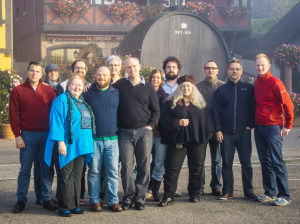
Why Should I Care About Agile Chartering?
Better teams create better outcomes. Agile Chartering is a vehicle to start teams off for success.
 At the end of last October, I participated in a three-day international workshop in Itterswiller, France with thirteen other Agile consultants, trainers and coaches from the US, Canada, Germany, France, Finland and Spain. Our hosts were Diana Larsen, Deb Hartmann Preuss and Steve Holyer. They convened the workshop to discuss what they felt was a missing practice in the Agile world – how to successfully launch an Agile teams and projects.
At the end of last October, I participated in a three-day international workshop in Itterswiller, France with thirteen other Agile consultants, trainers and coaches from the US, Canada, Germany, France, Finland and Spain. Our hosts were Diana Larsen, Deb Hartmann Preuss and Steve Holyer. They convened the workshop to discuss what they felt was a missing practice in the Agile world – how to successfully launch an Agile teams and projects.
Ostensibly, we were in Itterswiller to discuss the concepts from Diana’s latest book, Liftoff: Launching Agile Teams and Projects. Using the Agile Chartering framework to define our own work, we soon recognized that the biggest impediment to greater adoption of Agile Chartering for Agile teams was simply a lack of understanding about the practice. So many Agile teams are launched with little (or no) chartering, that out first goal was to figure out a way to explain what is Agile Chartering and why it would be valuable for an Agile team.
Agile Chartering is an investment in working groups and projects to make them more successful. In contrast to other chartering techniques, Agile Chartering is about the needs of the project, but even more about the needs of the people delivering the project. An Agile Chartering workshop gives all stakeholders of a project a voice. It opens up the opportunity to co-create a common understanding of the project dynamics, its purpose and context. It creates co-ownership of the project within the project team and thereby higher commitment to the project’s goals.
The three main dimensions of Agile Chartering are:
- Purpose: the whole group revises the initial purpose statement and works out project vision, mission and mission tests, that are good enough for now (GEFN) to start.
- Alignment: the group works out, the values and principles in the project and it clearly defines who is in the core team.
- Context: in this dimension, the group figures out what the boundaries of the group are, how and with whom they will have to interact and does some risk and prospective analysis.
It is important to mention, that the outcome of an Agile Chartering workshop is not a final document. It will always be in a draft state and must be revised on a regular basis by the whole group, whenever the project or team changes or learns something new.
Over the next few months, I will be sharing more ideas and information about the three dimensions of purpose, alignment and context. In meantime, if you are looking to launch an Agile team in the next few months, contact me and let’s start your teams for success in 2015!





